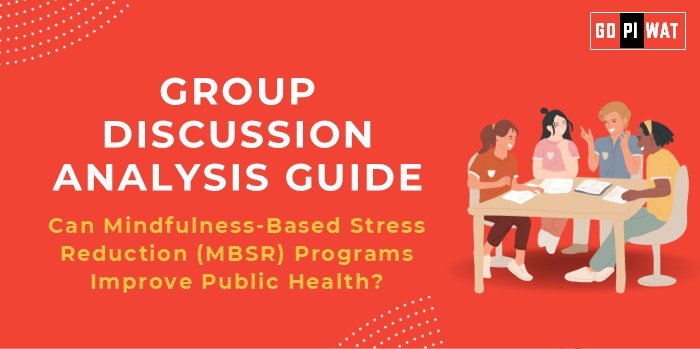📋 Group Discussion (GD) Analysis Guide: Can Mindfulness-Based Stress Reduction (MBSR) Programs Improve Public Health?
🌍 Introduction to MBSR Programs
📖 Opening Context
“In a world increasingly plagued by stress-induced disorders, mindfulness-based interventions such as MBSR are gaining recognition as essential tools for enhancing public health.”
📜 Topic Background
MBSR was developed in 1979 by Dr. Jon Kabat-Zinn to mitigate stress through mindfulness practices. Today, its applications extend globally across healthcare, workplaces, and educational institutions, addressing issues like anxiety, depression, and chronic pain.
📊 Quick Facts and Key Statistics
- 📅 Origin: MBSR was created at the University of Massachusetts Medical School in 1979.
- 🌍 Adoption: 1,300+ certified MBSR instructors operate worldwide.
- 📉 Impact Data: Studies show up to 38% reduction in stress levels among participants (American Psychological Association, 2023).
- 💰 Cost-Effectiveness: A 2022 UK study indicated an average healthcare cost savings of $650 per MBSR participant annually.
🤝 Stakeholders and Their Roles
- 🏥 Healthcare Providers: Facilitate program delivery and integrate mindfulness into treatment protocols.
- 🏛️ Governments and Policymakers: Advocate for inclusion in public health initiatives.
- 🎓 Educational Institutions: Promote MBSR among students to address mental health crises.
- 💼 Corporate Sector: Integrate programs to boost employee well-being and productivity.
🏆 Achievements and Challenges
✨ Achievements
- 📈 Stress Management: Proven efficacy in reducing stress and anxiety levels in diverse populations.
- 💊 Chronic Illness Support: Enhances quality of life for patients with chronic pain or terminal illnesses.
- 💵 Cost Reduction: Reduces reliance on pharmacological treatments, lowering healthcare expenditure.
- 👨💻 Workplace Productivity: Employers report improved employee focus and reduced absenteeism.
⚠️ Challenges
- 📉 Access Inequality: Limited reach in underserved and rural communities.
- 🌍 Cultural Adaptability: Resistance due to varying perceptions of mindfulness practices.
- 🔍 Evidence Limitations: Inconsistent outcomes across demographic groups.
🌎 Global Comparisons
- 🇺🇸 United States: Widespread adoption in corporate wellness programs.
- 🇬🇧 United Kingdom: National Health Service (NHS) incorporates mindfulness in mental health services.
- 🇮🇳 India: Increasing MBSR use in urban wellness centers but limited rural penetration.
📖 Case Studies
California’s Kaiser Permanente Health System demonstrated a 40% reduction in mental health outpatient visits post-MBSR program integration.
💡 Structured Arguments for Discussion
- 👍 Supporting Stance: “MBSR programs reduce healthcare costs and improve mental well-being, making them indispensable for public health strategies.”
- 👎 Opposing Stance: “While beneficial, MBSR programs face limitations such as scalability issues and inconsistent outcomes, questioning their universal applicability.”
- ⚖️ Balanced Perspective: “MBSR has significant potential to improve public health but requires improved accessibility and evidence-based implementation.”
📈 Effective Discussion Approaches
🔑 Opening Approaches
- 📊 Start with a statistic: “Stress contributes to 77% of health problems in urban populations globally, making MBSR critical for modern healthcare.”
- 📖 Highlight a success story: “The NHS Mindfulness Initiative improved mental health metrics for 65% of its participants in just 8 weeks.”
🤔 Counter-Argument Handling
- ⚖️ Acknowledge cost barriers and offer alternatives like community-based MBSR programs.
- 🔍 Emphasize ongoing research to address inconsistencies in program outcomes.
🔍 Strategic Analysis of Strengths and Weaknesses
- 🌟 Strengths: Scientifically validated benefits, growing acceptance in medical communities.
- ⚠️ Weaknesses: Limited accessibility, cultural barriers.
- 🚀 Opportunities: Integration into digital health platforms, partnerships with insurers.
- ⚡ Threats: Over-commercialization diluting efficacy, skepticism about measurable outcomes.
📚 Connecting with B-School Applications
- 🌐 Real-World Applications:
- 📋 Opportunities in healthcare operations and policy-making.
- 💬 Sample Interview Questions:
- 🧠 “How can MBSR be integrated into corporate wellness programs to boost productivity?”
- 📜 “Discuss the challenges of making MBSR a mainstream public health tool.”
- 💡 Insights for Students:
- 📈 Study the scalability of wellness interventions.
- 💵 Analyze their economic impact on healthcare systems.


